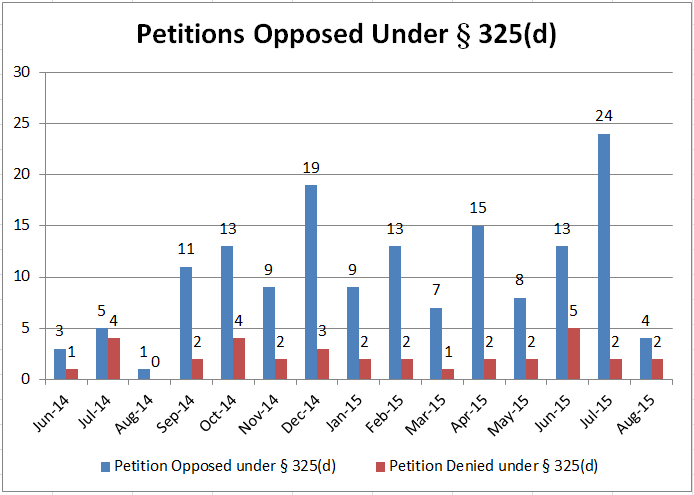One issue which we’ve been keeping an eye on is the Patent Trial and Appeal Board’s use of its discretion under 35 U.S.C. § 325(d) to deny institution of inter partes review for petitions using “the same or substantially the same prior art or arguments previously [ ] presented to the Office.” (See our previous posts on the topic here and here.)
In an effort to better understand the Board’s use of § 325(d) we reviewed every institution decision issued by the Board in the last 15 months to see (1) whether a petition was opposed under this statutory provision and (2) whether institution was denied as a result. The results of this study, described in greater detail below, suggest that § 325(d) remains rarely used by the Board. That said, Petitioners still must account for this statutory provision by including different prior art or grounds of rejection in the petition, explaining those differences to the Board, and ensuring a proper petition is filed in the first instance to avoid a “second bite” rejection.
- Challenge Rate and Success Rate of § 325(d) Oppositions
Only about 11% of all petitions for inter partes review face a challenge under § 325(d). Although such challenges are generally brought by a patent owner in its preliminary response to a petition, the Board can also raise the issue of “the same or substantially the same prior art or arguments” sua sponte in their institution decision. The pie chart below shows that while the Board issued 1,392 institution decisions since June 1, 2014, only 154 of them have involved a challenge under § 325(d).
In those cases where a petition was challenged under § 325(d), the Board declined to institute the inter partes review for some or all challenged claims 22% of the time (34 of the 154 cases involving a challenge under § 325(d)). Although a 22% success rate for patent owners raising this argument is substantial, it remains that the Board has denied institution of just 2.4% of inter partes review petitions by using the discretion granted by § 325(d).
2. Trends in Challenge Rate and Success Rate of § 325(d) Oppositions
Some practitioners have expressed concern that the broad discretion given to the Board in § 325(d) might be used to help clear the docket if and when the Board begins to experience a backlog of inter partes review cases. To date, this has not happened. The graph below illustrates the number of cases per month in which § 325(d) was raised (in blue) and used to deny institution (in red):
Adding trendlines to the data, it can be seen that although patent owners appear to be raising the issue of “the same or substantially the same prior art or arguments” more frequently, the Board has maintained a fairly consistent rate of denying institution on such grounds:



